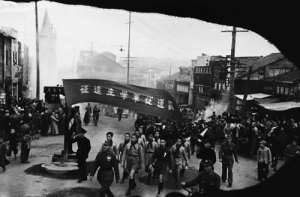![]() The Pacific War Online Encyclopedia
The Pacific War Online Encyclopedia
|
| Previous: Chung Pin | Table of Contents | Next: Churchill, Winston S. |

Chungking (Chongqing; 106.561E 29.579N) is the largest city of the Szechuan Plain, a relatively isolated region of China, which is readily accessible only through the Yangtze Gorges. It is located on a rocky promontory between the Yangtze and Kialing Rivers that has been inhabited for over 2000 years: The first walled city was built here in 320 B.C. The population in 1937 was almost 474,000, but refugees had swollen the population to about 700,000 in 1941 and to 1.05 million by 1945.
The Chinese nationalist government fled to Chungking in 1937, prior to the Pacific War, and was subject to heavy bombing throughout the war, beginning on 15 January 1939. There were particularly destructive raids on 3 and 4 May 1939 by 36 and 27 Japanese naval bombers. Some 3991 persons were kiled and 5411 homes destroyed; harbingers of the greater horrors that the world would see in the years to come. Another raid on 20 August 1940, part of a prolonged air campaign called Operation 101, involved 170 Japanese aircraft dropping incendiaries. Some 2000 tons of bombs were dropped on Chungking alone during the campaign, and destruction and loss of life soared. There was respite for the bombing only in autumn and winter, when the city was often enveloped in fog. During the three years of 1939-1941, the city was attacked 141 times, was hit by 15,000 bombs, and suffered casualties of 10,000 killed and 10,000 homes destroyed. The city above ground was reduced to little more than rubble.
However, the caves in the rocky hills of the
city served as
effective air
raid shelters. Journalist Leland Stowe described the city thus (Larrabee
1987):
The bluff is scarred by innumerable ravines and gullies, and its limestone cliffs and hillsides sheer off and fall with startling sharpness. Yet on all sides and in every crevice drab dwellings, some with slate roofs and others of new or fading thatched straw, cling to the sudden slopes like colonies of swallows' nests.
Coal was mined in
the area (300,000 tons per year) and Chungking had something of the character of a mining town.
The Japanese planned a campaign against the city as early as 1942,
when plans were made to take the city with sixteen divisions in a five-month campaign. However, reverses at Guadalcanal and elsewhere delayed the campaign until late 1944, when Japanese success in the Ichi-go operation created a real threat of invasion by 11 Army. This required the transfer of all Chinese forces in Burma back to China to repel the offensive. Fortunately for the Allies, the liberation of Mandalay ensured that the offensive in Burma could continue without Chinese assistance.
Climate Information:
Elevation 755'
Temperatures: Jan 49/41, Apr 73/60, Jul 93/76, Oct 71/61, record 111/29
Rainfall: Jan 4/0.6, Apr 9/3.9, Jul 6/5.6, Oct 13/4.4 == 42.9" per annum
References
The Pacific War Online Encyclopedia © 2007, 2011, 2015 by Kent G. Budge. Index